![]()
![]()
![]()
Use LEFT and RIGHT arrow keys to navigate between flashcards;
Use UP and DOWN arrow keys to flip the card;
H to show hint;
A reads text to speech;
211 Cards in this Set
- Front
- Back
- 3rd side (hint)
|
What is the regional term for your head/skull? |
Cranial. |
|
|
|
What is the regional term for your forehead? |
Frontal. |
|
|
|
What is the regional term for your eye/eyebrow/brow bone? |
Orbital. |
|
|
|
What is the regional term for your nose? |
Nasal. |
|
|
|
What is the regional word for your cheekbone? |
Buccal. |
|
|
|
What is the regional word for your ear? |
Otic. |
|
|
|
What is the regional word for your mouth? |
Oral. |
|
|
|
What is the regional word for the back of your head? |
Occipital. |
|
|
|
What is the regional term for where your hairline ends on the back of your head/high up on your neck? |
Nuchal. |
|
|
|
What is the regional term for your chin? |
Mental. |
|
|
|
What is the regional word for your neck? |
Cervical. |
|
|
|
What is the regional term for your shoulder? |
Acromial. |
|
|
|
What is the regional term for your shoulder blades? |
Scapular. |
|
|
|
What is the regional term for the middle of your chest? |
Sternal. |
|
|
|
What is the regional term for where your ribs start? |
Thoracic. |
It’s the same name as the vertebrae that your ribs attach to. |
|
|
What is the regional term for your armpit? |
Axillary. |
|
|
|
What is the regional term for your nipples/boobs? |
Mammary. |
|
|
|
What is the regional term for the part of your arm above your elbow/your “guns”? |
Brachial. |
|
|
|
What is the regional term for the front of your elbows (in anatomical position)? |
Antecubital. |
|
|
|
What is the regional term for your spine? |
Vertebral. |
|
|
|
What is the regional term for the portion of the body where your abs are? |
Abdominal. |
|
|
|
What is the regional term for your belly button? |
Umbilical. |
|
|
|
What is the regional term for your forearm/the distal arm/the portion of the arm below the elbow? |
Antebrachial. |
|
|
|
What is the regional term for your wrist? |
Carpal. |
|
|
|
What is the regional term for the back of your hand? |
Manual. |
|
|
|
What is the regional term for your palms? |
Palmar. |
|
|
|
What is the regional term for your fingers? |
Digital. |
|
|
|
What is the regional term for the part of the body that is below the stomach/the triangle of doom when you are on your period? |
Pelvic. |
|
|
|
What is the regional term for the lower back? |
Lumbar. |
|
|
|
What is the regional term for your booty? |
Gluteal. |
|
|
|
What is the regional term for the area really close to your no-no square, but not your no-no square. Below your pelvic area. |
Inguinal. |
|
|
|
What is regional term for the no-no square? (You have hair there!) |
Pubic. |
|
|
|
What is the regional term for the thigh? |
Femoral. |
|
|
|
What is the regional term for the knee? |
Patellar. |
|
|
|
What is the regional term for the back of the knee? |
Popliteal. |
|
|
|
What is the regional term for the front of your lower leg? |
Crural. |
|
|
|
What is the regional term for your calf muscle area/back of the lower leg? |
Sural. |
|
|
|
What is the regional term for your ankle? |
Tarsal! |
|
|
|
What is the regional term for your foot? |
Pedal. |
|
|
|
What is the regional term for your heel? |
Calcaneal. |
|
|
|
What is the regional term for the bottom of your foot? |
Plantar. |
|
|
|
You find the liver, pancreas, gallbladder, duodenum, and transverse colon in what quadrant? |
The right upper quadrant. |
|
|
|
You find the liver, pancreas, gallbladder, duodenum, and transverse colon in what quadrant? |
The right upper quadrant. |
|
|
|
You find the liver, stomach, spleen, pancreas, and transverse colon in which quadrant? |
The left upper. |
|
|
|
You find the ascending colon, small intestine, appendix, and urinary bladder in which quadrant? |
The right lower. |
|
|
|
You find the small intestine, descending colon, and urinary bladder in which quadrant? |
The left lower. |
|
|
|
The _______________ is the outer boundary of the cell, it is composed of a phospholipid bilayer. |
Plasma membrane. |
|
|
|
The ________ is the material inside of the cell, it consists of cytosol, the cytoskeleton, and organelles. |
Cytoplasm. |
|
|
|
________________ is the fluid portion of the cytoplasm and contains water, solutes, RNA enzymes, and other proteins. |
Cytosol. |
|
|
|
_____________ is a collection of protein filaments including actin filaments, intermediate filaments, and microtubules. |
The cytoskeleton. |
|
|
|
_________ are small, hairlike extensions that bear rhythmically together to propel substances past the cell. |
Cilia. |
|
|
|
__________ are single extensions that propel the cell itself- sperm are the only flagellated cells in the human body. |
Flagella. |
|
|
|
___________ are specialized cellular compartments that caddy out a variety of functions. |
Organelles. |
|
|
|
___________ are composed of two subunits, they are the sites of protein synthesis in the cell. |
Ribosomes. |
|
|
|
__________ contain enzymes that catalyze reactions to detoxify chemicals produced by cellular reactions, metabolic fatty acids, and synthesize certain phospholipids. |
Peroxisomes. |
|
|
|
___________ produces the bulk of the cell’s ATP. It is the “powerhouse of the cell.” |
Mitochondria. |
|
|
|
___________ has ribosomes on its surface, it modifies proteins that ribosomes have made. |
Rough endoplasmic reticulum. |
|
|
|
___________ lacks ribosomes, but has multiple functions- lipid synthesis and detoxification reactions. |
Smooth endoplasmic reticulum. |
|
|
|
__________ is a stack of flattened sacs, it received vesicles from the RER and other places in the cell and process, modify, and sort products within the vesicles. |
Golgi apparatus. |
|
|
|
__________ are membrane-enclosed vesicular organelles filled with digestive enzymes that catalyze reactions that digest particles brought into the cell, old and worn out organelles and then the cell itself. They break things down. |
Lysosomes. |
|
|
|
What is the regional term for the entire head? |
Cephalic |
|
|
|
The portions of the cell cycle from G1-G2 are collectively called ______________. |
Interphase. |
|
|
|
The ________ portion of the cell cycle is the initial growth phase during which the cell grows, develops, and carries out activities that are specific to that cell type. |
G1. |
|
|
|
The __________ portion of the cell cycle is the period during which the Cell’s DNA is replicated. |
S Phase. |
|
|
|
__________ is the second growth phase during which the cell makes its final preparations for division. (Cell cycle.) |
G2. |
|
|
|
___________ is the phase during which the cell undergoes the process of mitosis. |
M Phase. |
|
|
|
__________ is when a a cell divides and DNA is replicated among two identical daughter cells. |
Mitosis. |
|
|
|
__________ is the process where the mother cell’s cytoplasm is distributed between the two daughter cells. |
Cytokinesis. |
|
|
|
What are the four stages of mitosis, in order? |
Prophase Metaphase Anaphase Telophase |
|
|
|
During ____________ we see the sister chromatids, attached to the spindle fibers, line up along the equator of the call. |
Metaphase. |
They are all meeting in the m-m-m-middle! |
|
|
In ___________ a divot forms between the two cells called a cleavage furrow. As the cleavage furrow progressively narrows, the cell is pinched into two identical daughter cells and cytokinesis is completed. During this stage the nuclear membranes begin to reassemble, the mitotic spindle becomes less visible, and DNA returns to its chromatin form. |
Telophase. |
|
|
|
__________ is the last stage of mitosis. |
Telophase. |
|
|
|
________ is the first stage of mitosis. |
Prophase. |
|
|
|
During _____________ we see the spindle finders shorten, which pulls the centromeres apart, and the sister chromatids migrate toward the opposite poles of the cell. In addition, cytokinesis begins. |
Anaphase. |
|
|
|
During _________ the nuclear membrane starts to degenerate, and the chromatin condensed into individual chromosomes. The mitotic spindle organizes around the centrioles which begin migrating to opposite poles of the cell. By the end _____________, the centrioles have redhead the opposite poles of the cell. Spindle fibers emanate from each side of the mitotic spindle and attached to a structure known as the centromere that joins the two sister chromatids- one spindle fiber attaches to each side of the centromere. |
Prophase; prophase. |
This part of the cell cycle is productive. |
|
|
The ____________ joins the two sister chromatids. |
Centromere. |
|
|
|
In what stage of mitosis does a cleavage furrow appear? |
Telophase. |
|
|
|
What are the two body cavities? |
Dorsal & Ventral. |
|
|
|
What are the cavities of the dorsal cavity? |
Cranial and vertebral. |
|
|
|
What are the cavities of the ventral cavity? |
Thoracic and abdominopelvic. |
|
|
|
What is the thoracic cavity composed of? |
The mediastinum and pleural cavities. |
|
|
|
What is the abdominopelvic cavity composed of? |
The abdominal and pelvic cavities. |
|
|
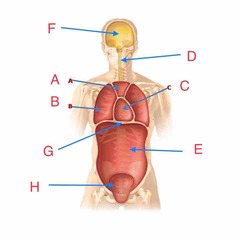
What is A pointing to? |
The mediastinum. (Spell it!) |
|
|

What is B pointing to? |
The pleural cavity. It is inside the thoracic cavity. (Spell it!) |
|
|
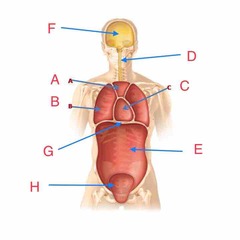
What is C pointing to? |
The pericardial cavity. It is inside the thoracic cavity. (Spell it!) |
|
|

What is D pointing to? |
The vertebral cavity. It is inside the dorsal/posterior cavity. |
|
|

What is E pointing to? |
The abdominal cavity. It is in the abdominopelvic cavity. |
|
|
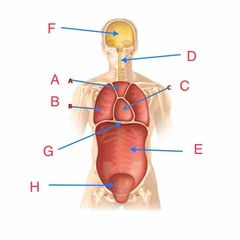
What is F pointing to? |
The cranial cavity. It is inside the dorsal/posterior cavity. |
|
|
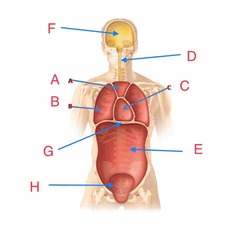
What is G pointing to? |
The diaphragm. (Spell it!!!) |
|
|
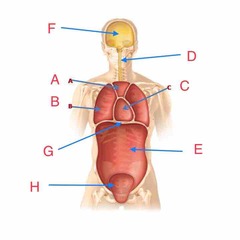
What is H pointing to? |
The pelvic cavity. It is in the abdominopelvic cavity. |
|
|
|
Several of the fluid-filled body cavities are formed by thin sheets of tissue called _______________. |
Serous membranes. |
|
|
|
Serous membranes are composed of two layers: an outer layer called the ___________, and the inner layered called _____________. |
Parietal (outer); Visceral (inner). |
|
|
|
The __________ layer is attached to the body wall and surrounding structures. |
Parietal. |
|
|
|
The __________ layer is attached to specific organs. |
Visceral. |
|
|
|
The _____________ are attached to the body wall and the surface of the diaphragm. |
Parietal pleurae. |
|
|
|
The _____________ are attached to the surface of the lungs. Between the two layers we find a thin layer of serous fluid. |
Visceral pleurae. |
|
|
|
In the mediastinum we find the ___________ which is attached to surrounding structures and the __________ which is attached to the heart muscle. |
Parietal pericardium; visceral pericardium. |
|
|
|
In the peritoneal cavity we find the __________ which is attached to the body wall and surrounding structures, and the ___________ which is attached to the surface of many of the abdominal and pelvic organs. |
Parietal peritoneum; visceral peritoneum. |
|
|
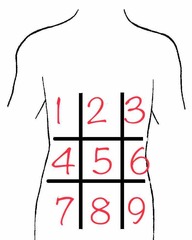
List the 9 regions in order. Remember it is in anatomical position. |
(1) Right hypochondriac region (2) epigastric region (3) left hypochondriac region (4) right lumbar region (5) umbilical region (6) left lumbar region (7) right iliac region (8) hypogastric region (9) left iliac region |
|
|
|
What are the four quadrants? |
Right upper quadrant. Left upper quadrant. Right lower quadrant. Left lower quadrant. |
|
|
|
What are the main organs of the integumentary system? |
Hair, skin, nails. |
|
|
|
What is the main function of the integumentary system? |
- encloses internal body structures. - site of many sensory receptors. |
|
|
|
What are the main organs of the muscular system? |
Skeletal muscles, tendons. |
|
|
|
What is the main functions of the muscular system? |
- enables movement (with skeletal system) - helps maintain body temp. |
|
|
|
What are the main organs of the skeletal system? |
Cartilage. Bones. Joints. |
|
|
|
What are the main functions of the skeletal system? |
- supports the body. - enables movement (with the muscular system). |
|
|
|
What are the main organs in the nervous system? |
Brain, spinal cord, peripheral nerves. |
|
|
|
What are the main functions of the nervous system? |
- detects and processes sensory information. - activated bodily responses. |
|
|
|
What are the main organs of the endocrine system? |
The pituitary gland, thyroid gland, pancreas, adrenal glands, testes/ovaries. |
|
|
|
What are the main functions of the endocrine system? |
- Secretes hormones - Regulates bodily processes. |
|
|
|
What are the main organs of the lymphatic system? |
Thymus, lymph nodes, spleen, lymphatic vessels. |
|
|
|
What are the main functions of the lymphatic system? |
- returns fluid to blood. - defends against pathogens. |
|
|
|
What are the main organs of the cardiovascular system? |
Heart, blood vessels. |
|
|
|
What are the main functions of the cardiovascular system? |
- delivers oxygen and nutrients to tissues. - Equalizes temperature in the body. |
|
|
|
What are the main organs of the respiratory system? |
Nasal passageways, trachea, lungs. |
|
|
|
What are the main organs of the respiratory system? |
Nasal passageways, trachea, lungs. |
|
|
|
What are the main functions of the respiratory system? |
- removes carbon dioxide from the body. - delivers oxygen to blood. |
|
|
|
What are the main organs of the digestive system? |
Stomach, liver, gallbladder, large intestine, small intestine. |
|
|
|
What are the functions of the digestive system? |
- processes food for use by the body. - removes wastes from undigested food. |
|
|
|
What are the main organs of the male reproductive system? |
Epididymis, testes. |
|
|
|
What are the main functions of the male reproductive system? |
- produces sex hormones and gametes. - delivers gametes to female. |
|
|
|
What are the main organs of the urinary system? |
Kidneys, urinary bladder. |
|
|
|
What are the main functions of the urinary system? |
- controls water balance in the body. - removes waste from mood and excreted them. |
|
|
|
What are the main functions of the urinary system? |
- controls water balance in the body. - removes waste from mood and excreted them. |
|
|
|
What are the main organs in he female reproductive system? |
Mammary glands, ovaries, uterus. |
|
|
|
What are the main functions of the urinary system? |
- controls water balance in the body. - removes waste from mood and excreted them. |
|
|
|
What are the main organs in he female reproductive system? |
Mammary glands, ovaries, uterus. |
|
|
|
What are the main functions of the female reproductive system? |
- produces hormones and gametes. - supports embryo/fetus until birth. - produces milk for infant. |
|
|
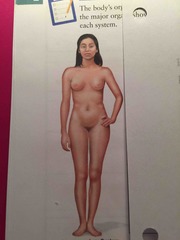
What body system is this? |
The integumentary system. |
|
|
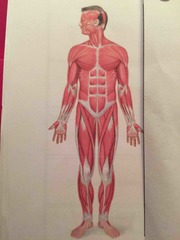
What body system is this? |
The muscular system. |
|
|
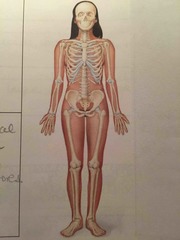
What body system is this? |
The skeletal system. |
|
|
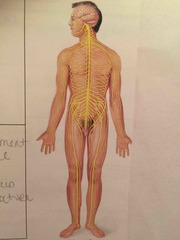
What body system is this? |
The nervous system. |
|
|
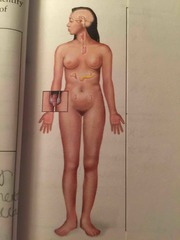
What body system is this? |
The endocrine system. |
|
|

What body system is this? |
The lymphatic system. |
|
|

What body system is this? |
The cardiovascular system. |
|
|
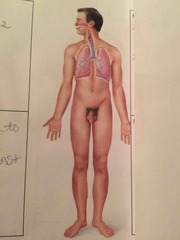
What body system is this? |
The respiratory system. |
|
|

What body system is this? |
The digestive system. |
|
|
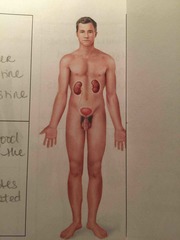
What organ system is this? |
The urinary system. |
|
|
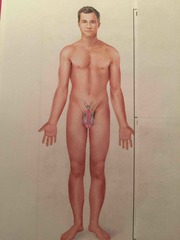
What body system is this? |
The male reproductive system. |
|
|
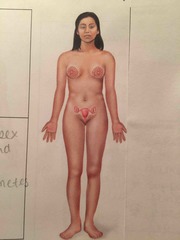
What body system is this? |
The female reproductive system. |
|
|
|
What are the ten part of the compound microscope you need to know? Go over them mentally and out loud. |
Arm, body tubes, ocular lens, nosepiece, objective lenses, base, power switch, light control, stage, focus knobs- fine and coarse. |
|
|
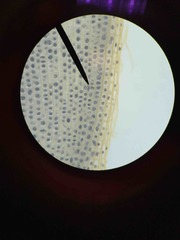
What stage of cell division is this? (Look at hint if needed.) |

Prophase! |
Polka dot border! |
|

What phase of mitosis is this? |

Metaphase! (They’re meeting in the middle!) |
|
|

What stage of mitosis is this? |
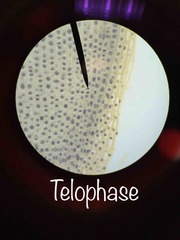
Telophase! (They are taking some space from each other and pulling away.) |
|
|
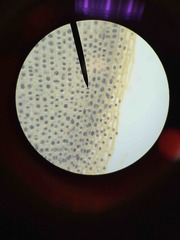
What stage of mitosis is this? |
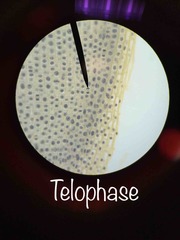
Telophase! (They are taking some space from each other and pulling away.) |
|
|
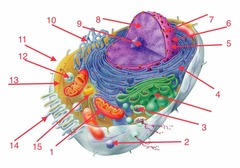
What is 1 pointing to? |
The mitochondrion. |
|
|
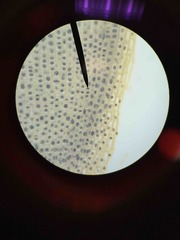
What stage of mitosis is this? |
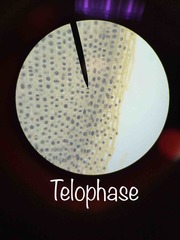
Telophase! (They are taking some space from each other and pulling away.) |
|
|
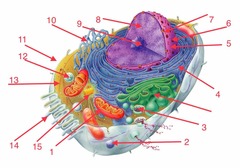
What is 1 pointing to? |
The mitochondrion. |
|
|
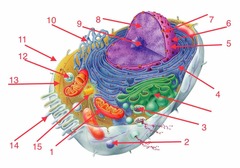
What is 2 pointing to? |
The lysosome. |
|
|
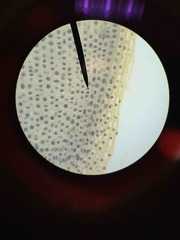
What stage of mitosis is this? |
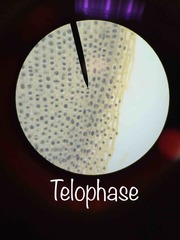
Telophase! (They are taking some space from each other and pulling away.) |
|
|
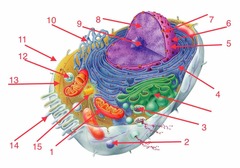
What is 1 pointing to? |
The mitochondrion. |
|
|
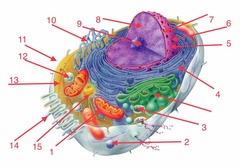
What is 2 pointing to? |
The lysosome. |
|
|
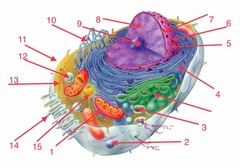
What is 3 pointing to? |
A vesicle. |
|
|

What stage of mitosis is this? |
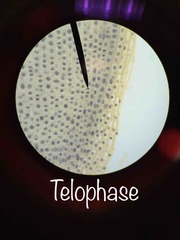
Telophase! (They are taking some space from each other and pulling away.) |
|
|
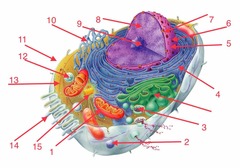
What is 1 pointing to? |
The mitochondrion. |
|
|

What is 2 pointing to? |
The lysosome. |
|
|

What is 3 pointing to? |
A vesicle. |
|
|
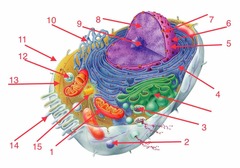
What is 4 pointing to? |
Rough endoplasmic reticulum? |
|
|

What is 5 pointing to? |
The nucleus. |
|
|
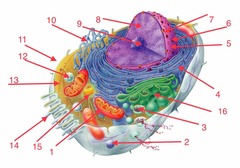
What is 5 pointing to? |
The nucleus. |
|
|
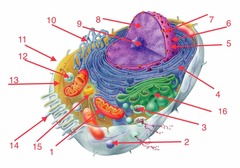
What is 6 pointing to? |
A nuclear pore. |
|
|
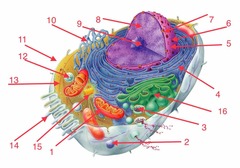
What is 5 pointing to? |
The nucleus. |
|
|
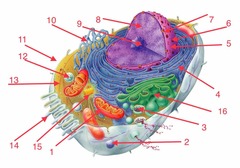
What is 6 pointing to? |
A nuclear pore. |
|
|
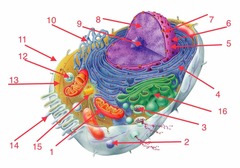
What is 7 pointing to? |
The nuclear envelope. |
|
|
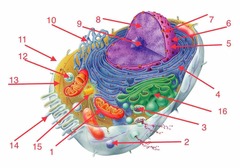
What is 5 pointing to? |
The nucleus. |
|
|
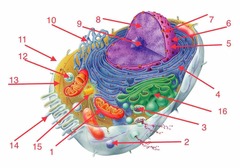
What is 6 pointing to? |
A nuclear pore. |
|
|
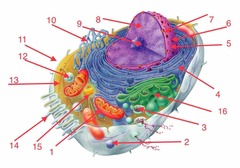
What is 7 pointing to? |
The nuclear envelope. |
|
|
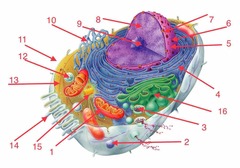
What is 8 pointing to? |
The chromatin. |
|
|
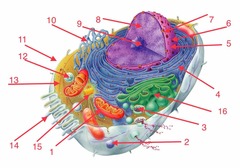
What is 9 pointing to? |
The nucleolus. |
|
|
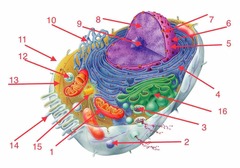
What is 9 pointing to? |
The nucleolus. |
|
|
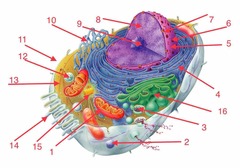
What is 10 pointing to? |
Smooth endoplasmic reticulum. |
|
|
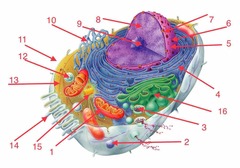
What is 11 pointing to? |
The plasma membrane. |
|
|
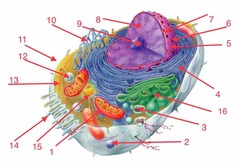
What is 12 pointing to? |
A peroxisome. |
|
|
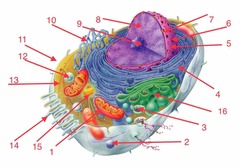
What is 13 pointing to? |
The cytosol. |
|
|
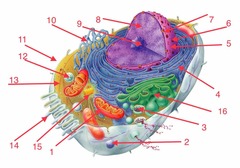
What is 14 pointing to? |
Microvilli. |
|
|

What is 15 pointing to? |
The centrioles. |
|
|
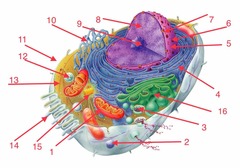
What is 16 pointing to? |
The Golgi apparatus. |
|
|
|
What are the various magnifications of the objective lenses? |
4x, 10x, 40x, 100x. |
|
|
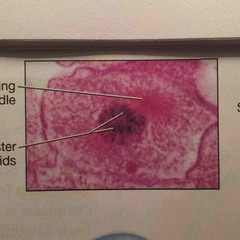
What is this stage of cell division? |
Prophase. |
|
|

What is this stage of cell division? |
Interphase. |
|
|
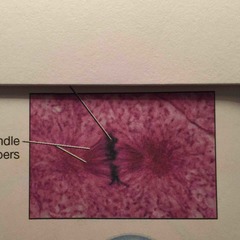
What is this stage of cell division? |
Metaphase. |
|
|
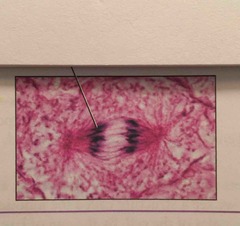
What is this stage of cell division? |
Anaphase. |
|
|
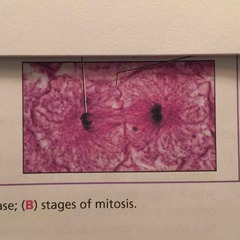
What is this stage of cell division? |
Telophase. |
|
|
|
Proximal/distal are only used on or refer to the ______________ region. |
Appendicular. |
|
|
|
_______ is defined as the movement of SOLUTE molecules from a high concentration to a low concentration until a state of equilibrium is reached. |
Diffusion. |
|
|
|
A ______________ is defined as a situation in which two connected areas have different concentrations of a solute. |
Concentration gradient. |
|
|
|
Diffusion refers to the ___________, while osmosis is the ___________. |
(1) movement of solute. (2) movement of solvent. |
|
|
|
___________ is the movement of solvent from a solution with a lower solute convention to a solution with a higher solute concentration. |
Osmosis. |
|
|
|
What are the three variations in tonicity? |
Isotonic, hypotonic, hypertonic. |
|
|
|
What are the three variations in tonicity? |
Isotonic, hypotonic, hypertonic. |
|
|
|
A(n) ___________ ECF has the same solute concentration as the cytosol. |
Isotonic. |
|
|
|
A(n) _____________ ECF has a lower solute concentration that the cytosol. |
Hypotonic. |
|
|
|
A(n) ______________ ECF has a higher solute concentration that the cytosol. |
Hypertonic. |
|
|
|
What is the primary component of the plasma membrane? |
Phospholipids. |
|
|
|
What 3 factors influence the rate at which diffusion takes place? |
Size of particles, temperature, and steepness of the concentration gradient. |
|
|
|
Mitotic spindle fibers are composed of ___________. |
Microtubules. |
|
|
|
What fibers are found in areolar connective tissue and how do you know which are which? |
Elastic fibers- thin and purple. Collagen fibers- thick and pink. |
|
|
|
___________ is a substance consisting of DNA and associated proteins. |
Chromatin. |
|
|
|
Within the nucleus are threads of __________ composes of DNA and associated proteins. |
Chromatin. |
|
|
|
__________ is the condensed version of chromatin. |
Chromosome. |
|
|
|
Each copy of the chromosome is referred to as a sister ___________ and is physically bound to the other copy. |
Chromatid. |
|
|
|
In ________ prophase the microtubules appear and attach themselves to the centromeres that adjoin pairs of sister chromatids. |
Late. |
|
|
|
_________ is the destruction of erythrocytes and the release of their hemoglobin into circulation. |
Hemolysis. |
|
|
|
The regional term for your hip/hip bone! |
Coxal. |
|
|
|
What is the regional term for the entire hand? |
Manus! |
|
|
|
What is the regional term for the area between your private areas and anus? |
Perineal. |
|
|
|
What is the regional term for the triangle right above your booty crack? It’s also right below the lumbar region. |
Sacral. |
|
|

What plane is A? |
Sagittal / Midsagittal. |
|
|
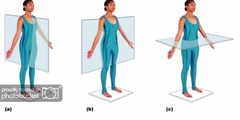
What plane is A? |
Sagittal / Midsagittal. |
|
|

What plans is B? |
Frontal / Coronal. |
|
|
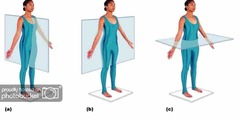
What body plane is C? |
Transverse. |
|

